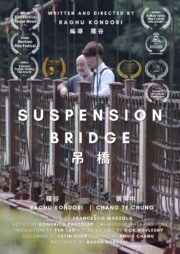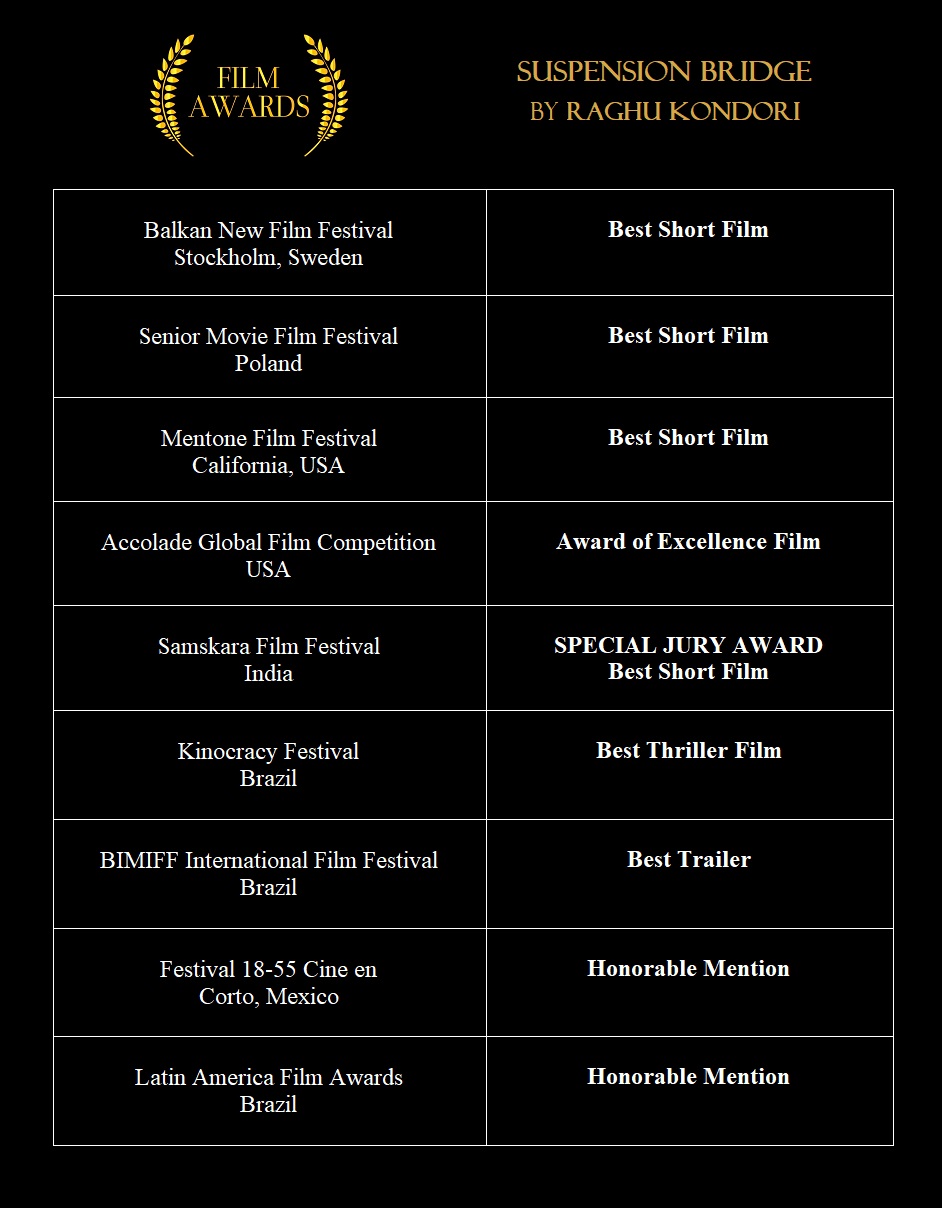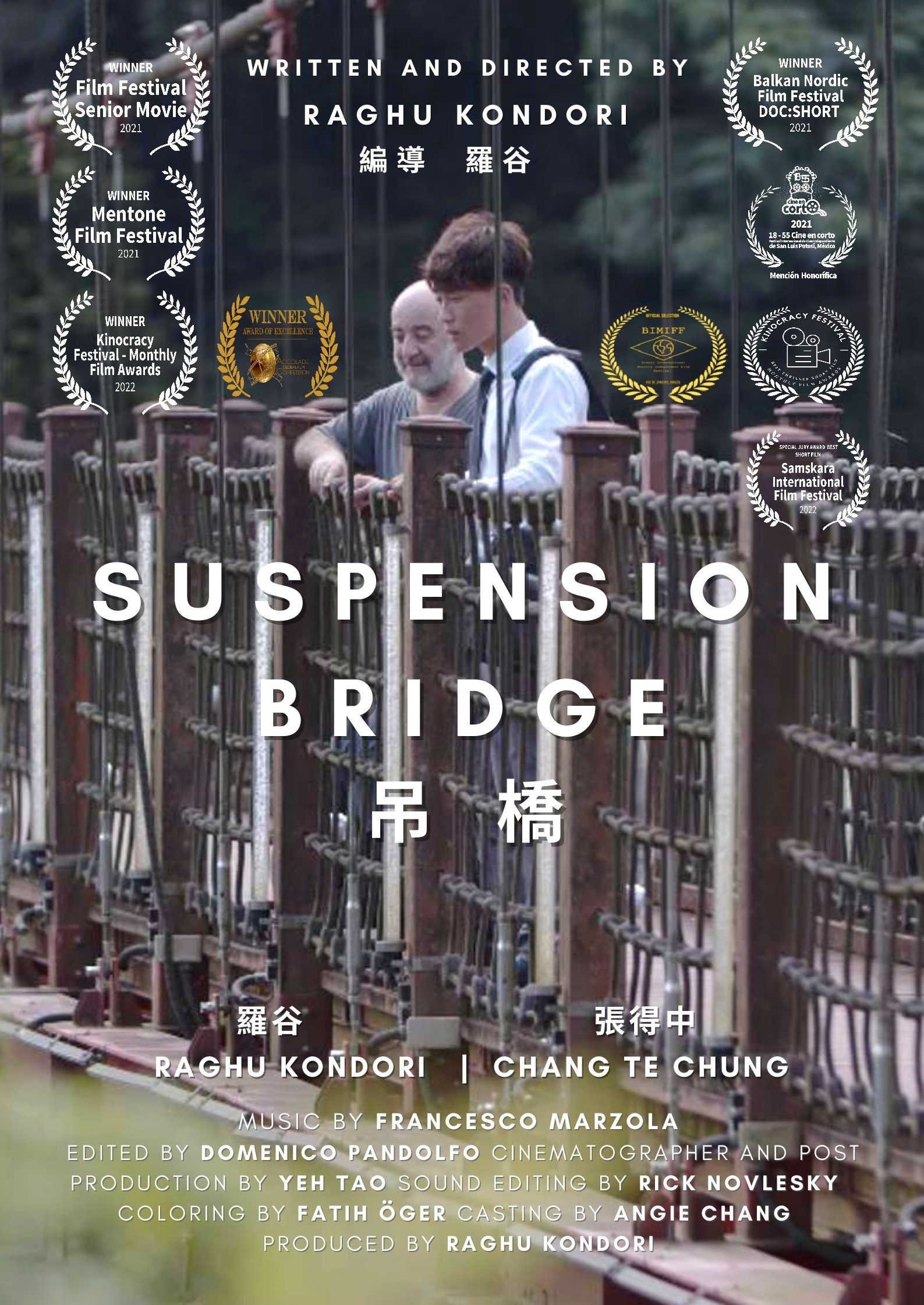Suspension Bridge

Suspension Bridge – A Poetic and Spiritual Odyssey at Dawn. A film by Raghu Kondori. It has been selected in over 50 festivals and has won more than 10 awards.
Suspension Bridge – A Poetic and Spiritual Odyssey at Dawn
Raghu Kondori’s Suspension Bridge, a critically acclaimed short film in English, filmed amid the breathtaking landscapes of Taiwan, is a haunting yet uplifting exploration of life’s fragility, resilience, and redemption. Selected in over 50 film festivals and awarded more than 10 honors—including Best Film, Best Actor, and Best Thriller—stands as a testament to the power of poetic storytelling and spiritual transcendence, offering viewers a deeply moving journey that lingers long after the credits roll.
A Liminal Dawn Unfolds
Suspension Bridge begins with a mesmerizing sequence that sets the stage for its profound emotional and spiritual journey. The film opens just before sunrise, immersing viewers in the profound darkness of predawn—a liminal space of anticipation and stillness. The image Kondori shares, depicting shadowy mountains, a winding road, and scattered lights, captures this initial moment of quiet tension. As the scene transitions, the first rays of sunrise break over Taiwan’s rugged montane landscape, bathing the mountains in a soft, golden glow. This shift from darkness to light is not merely visual but symbolic, hinting at the hope and renewal to come.
The camera then pans to a local temple nestled in the mountains, a quiet yet powerful presence that anchors the film in Taiwan’s cultural and spiritual heritage. Taiwan’s temples and hiking trails, such structures—often associated with Buddhism, Taoism, or indigenous traditions—are integral to the island’s identity, offering spaces for reflection and connection with nature. This brief glimpse of the temple, set against the montane backdrop, establishes a sense of place and prepares the viewer for the film’s poetic and spiritual undertones.
Finally, the narrative focuses on a young Taiwanese man standing on a suspension bridge, teetering on the edge of despair and contemplating suicide. This suspension bridge, likely inspired by Taiwan’s iconic structures like the Taiping Suspension Bridge or other high-mountain spans referenced in web discussions, becomes more than a setting—it’s a metaphorical threshold between life and death, isolation and connection. The bridge’s precarious span across a potentially turbulent river or deep valley mirrors the protagonist’s internal struggle, while the pre-dawn and sunrise moments underscore the film’s central theme: life as a river with “ups and downs,” a metaphor encapsulated in Kondori’s tagline, “Life is like a river with ups and downs—learn to swim.”
The Old Man’s Gentle Provocation
Into this moment of existential crisis steps the old man, played by Kondori himself, whose encounter with the young man becomes the film’s emotional and spiritual fulcrum. In a scene rich with subtlety and surprise, the old man approaches the despondent youth and asks, “Do you want to jump into the river and swim?” The young man, lost in his silence, offers no reply. Undeterred, the old man presses on: “Do you know how to swim?” Again, silence. Then, in a moment that shifts the tone, the old man says, “You don’t need your watch, your wallet, or your phone in the river. Give them all to me.”
At first, this exchange feels unsettling—viewers might suspect the old man is exploiting the young man’s desperation, an opportunist preying on vulnerability. But Suspension Bridge subverts this expectation with finesse. As the young man hands over his possessions, a spark ignites within him—an anger, a refusal to be stripped bare. This emotional awakening, provoked by the old man’s ruse, rekindles his attachment to life. When the young man demands his property back, the old man returns it without hesitation, a knowing smile beneath his gentle demeanor.
The scene crescendos as the young man prepares to leave, only for the old man to call out, “You forgot your watch, come get it.” Handing it back, the old man kneels to untie the young man’s shoelaces, then ties them again with care—a tender, almost paternal gesture. “Come to the pool after you finish your work,” he says softly. “I’ll teach you how to swim.” This promise, delivered as the sun rises fully, transforms the bridge from a site of despair into a threshold of renewal, encapsulating the film’s message of resilience and connection.
A Poetic and Spiritual Resolution
Suspension Bridge distinguishes itself through this poetic and spiritual approach, guiding the protagonist—and the audience—toward a rediscovery of life’s meaning. The old man’s interaction is not a sermon but a catalyst, using provocation and kindness to awaken the young man’s dormant will to live. The river metaphor takes on new depth here: life’s challenges are not merely to be endured but navigated with skill and courage—skills the old man offers to impart. The sunrise, now fully realized after the opening sequence, becomes a visual and emotional climax, symbolizing enlightenment, renewal, and the triumph of the human spirit over darkness.
This spiritual undertone is enriched by Taiwan’s philosophical heritage, including influences from Buddhism, Taoism, and indigenous traditions, which often frame sunrise as a moment of awakening and connection with nature. The local temple glimpsed earlier reinforces this connection, serving as a quiet nod to the spiritual resources available to the protagonist and viewers alike. Web resources on spiritual fitness and suicide prevention echo this approach, suggesting Suspension Bridge taps into universal and Eastern practices to offer a path forward.
Taiwan’s Landscape as Character
Filmed in Taiwan, Suspension Bridge leverages the country’s rugged terrain and iconic suspension bridges to deepen its narrative and visual impact. The opening sequence—from the pre-dawn mountains to the sunrise-drenched peaks, the local temple, and the bridge itself—transforms the landscape into a character in its own right. Kondori’s choice of location taps into a tradition of using the island’s natural beauty to explore profound human experiences.
The suspension bridge, with its precarious span, embodies the film’s central tension, while the scattered lights—perhaps from the temple, a distant village, or the first rays of dawn—hint at the human connection awaiting the young man. This visual poetry, captured in Kondori’s cinematography, aligns with the film’s festival success, earning accolades for its striking imagery and emotional resonance.
A Global Story with Local Roots
This cross-cultural approach has propelled the film to recognition at festivals worldwide, including the Balkan New Wave Film Festival, Senior Movie Poland Film Festival (where it won the Golden Cat), and Kinofest Brazil (Best Thriller).
The film’s success in over 50 festivals and more than 10 awards, including Best Film and Best Actor, underscores its emotional and artistic impact. Kondori’s performance as the old man—wry, tender, and transformative—likely contributed to the Best Actor nod, while his direction blends suspenseful drama with profound spirituality, earning critical acclaim.
Why Suspension Bridge Matters
Suspension Bridge is a call to resilience, a celebration of life’s cyclical nature, and a reminder of the transformative power of human connection. The film’s opening sequence—from the pre-dawn stillness to the sunrise, the montane temple, and the bridge—creates a narrative that is both thrilling and transcendent, offering a fresh perspective on mental health and survival. For those familiar with Taiwan’s cinematic heritage or its natural landmarks, the film provides a nuanced portrayal of a familiar landscape; for global viewers, its English-language narrative and universal themes resonate deeply, addressing the human condition with grace and insight.
In a world often overshadowed by darkness, Suspension Bridge illuminates the path to renewal—just as the first rays of dawn break over Taiwan’s mountains. Raghu Kondori’s debut is a triumph of poetic filmmaking, a spiritual odyssey that invites us to embrace life’s currents, untie our laces, and learn to swim toward the light.
Shahvand



